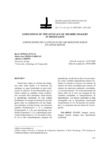Mostrar o rexistro simple do ítem
Limitations of the efficacy of bizare imagery in mixed lists
| dc.contributor.author | Gómez-Juncal, Rocío | |
| dc.contributor.author | Pérez-Fabello, María José | |
| dc.contributor.author | Campos, Alfredo | |
| dc.date.accessioned | 2011-07-12T11:01:43Z | |
| dc.date.available | 2011-07-12T11:01:43Z | |
| dc.date.issued | 2009 | |
| dc.identifier.citation | Revista galego-portuguesa de psicoloxía e educación, 2009, 17: 211-224. ISSN: 1138-1663 | es_ES |
| dc.identifier.issn | 1138-1663 | |
| dc.identifier.uri | http://hdl.handle.net/2183/7636 | |
| dc.description.abstract | [Resumen] Desde hace siglos se utilizan las imáge- nes raras como ayuda a la memoria, sin embargo, se sigue estudiando en qué condi- ciones es efectiva. Se ha demostrado que es eficaz cuando se cumplen varias condicio- nes: recuerdo libre inmediato, listas mixtas, y aprendizaje incidental. En este trabajo deseábamos investigar la eficacia de las imá- genes raras en comparación con las imáge- nes normales, en listas mixtas, con oraciones simples (Experimento1 y 2) y complejas (Experimento 3 y 4), con aprendizaje inci- dental (Experimto 1 y 3) y aprendizaje inten- cional (Experimento 2 y 4). Se midió el efec- to de lo raro inmediatamente después del aprendizaje, al cabo de un día y de una sema- na. Como variables dependientes hemos uti- lizado el recuerdo, el acceso a la oración, el número de ítems recordados por oración, el número de oraciones totalmente recordadas, y el reconocimiento. No se ha encontrado un efecto claro de lo raro con ninguna de las variables estudiadas, ni independientes, ni dependientes. Los peores resultados se han conseguido con el aprendizaje intencional (Experimento 2 y 4). Se discuten los resulta- dos y se proponen nuevas líneas de investi- gación. | es_ES |
| dc.description.abstract | [Abstract] For centuries bizarre imagery has been an aid to memory yet the precise conditions for its optimum effectiveness remain unknown. Bizarre imagery has been reported to be effec- tive under certain conditions: free immediate recall, mixed lists, and incidental learning. The aim of this study was to assess the efficacy of bizarre imagery in comparison to normal ima- gery, in mixed lists with simple sentences (Experiment 1 and 2) and complex sentences (Experiment 3 and 4), with incidental learning (Experiment 1 and 3) and intentional learning (Experiment 2 and 4). In all the experimental conditions, bizarre imagery was assessed immediately after learning, at a 1-day, and at a 1-week interval. Dependent variables were as follows: recall, sentence access, number of items recalled per sentence, number of senten- ces fully recalled, and recognition. No clear effect was found between bizarre and any of the independent or dependent variables under study. The lowest efficacy was observed with intentional learning (Experiment 2 and 4). The results are discussed in the light of further lines of investigation. | es_ES |
| dc.language.iso | eng | es_ES |
| dc.publisher | Universidade da Coruña | es_ES |
| dc.subject | Imagen mixta | es_ES |
| dc.subject | Imagen mental | es_ES |
| dc.subject | Imagen rara | es_ES |
| dc.subject | Aprendizaje incidental | es_ES |
| dc.subject | Mixed imagery | es_ES |
| dc.subject | Mental imagery | es_ES |
| dc.subject | Bizarre imagery | es_ES |
| dc.subject | Incidental imagery | es_ES |
| dc.title | Limitations of the efficacy of bizare imagery in mixed lists | es_ES |
| dc.type | info:eu-repo/semantics/article | es_ES |
| dc.rights.access | info:eu-repo/semantics/openAccess |






